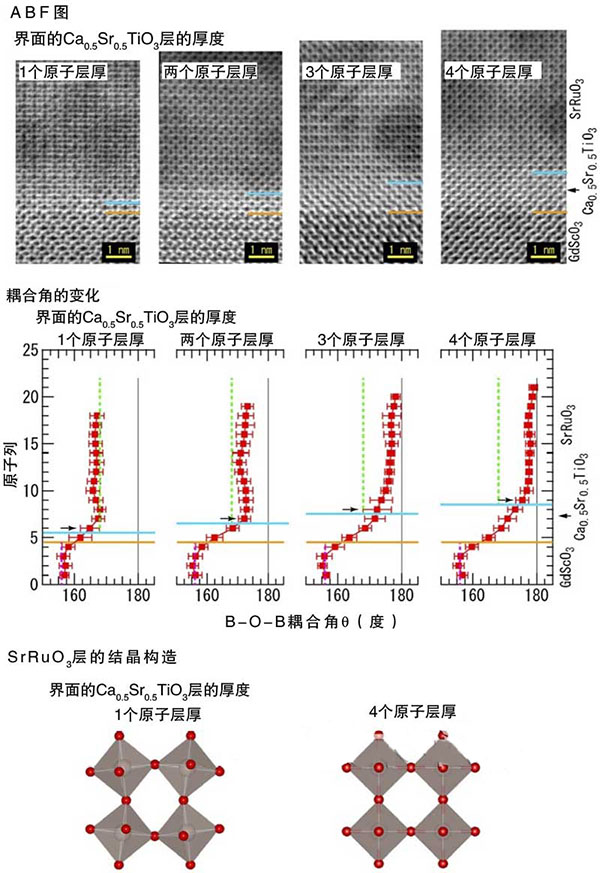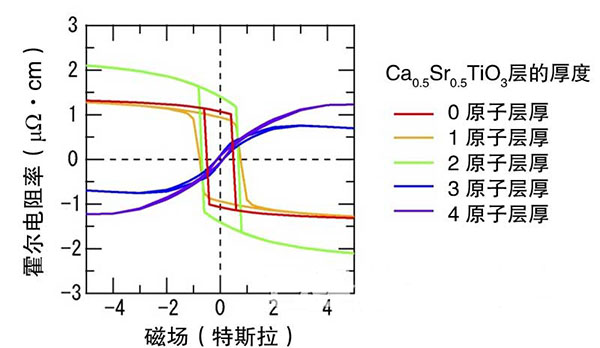 |
Schematic diagram of a perovskite structure. The angle between B ions and oxygen was evaluated as the coupling angle θ.

The thickness of the interface and the change in the coupling angle.

The Hall resistivity of the heterostructure formed by inserting 0 to 4 thick layers into the interface. It can be seen that when the thickness is less than two layers and more than three layers, the Hall resistor operates differently, and the magnetic characteristics change.
Kyoto University, Japan announced on March 8, 2016 that the heterostructure film composed of a transition metal oxide with a Provskite structure has successfully changed the oxygen coordination environment (coupling angle between transition metal and oxygen). Controlled film properties. According to reports, this will contribute to the development of new materials in the electronic and spintronic fields in the future.
Transition metal oxides can exhibit various characteristics that ordinary semiconductors cannot achieve, and are currently widely developed functional materials in the industry. In particular, perovskite oxides exhibit a variety of characteristics, and therefore their research as a new generation of electronic and spintronic materials is very popular. Moreover, with the continuous advancement of atomic-scale oxide manufacturing technology, it is now possible to realize heterostructures in which a thin film having a steep interface and a dissimilar material are joined together. Therefore, perovskite-structured oxides have been discovered as novel physical properties and new functions. Sexual places have attracted much attention.
This time, Kyoto University inserted a layer of Ca0.5Sr0.5TiO3 with a thickness of several atomic layers between the perovskite-structured oxides SrRuO3 and GdScO3, and investigated the detailed structure and characteristics of the resultant heterostructure thin film. The oxygen coordination environment in the SrRuO3 thin film layer depends on the coupling angle of the transition metal and oxygen in the heterointerface. It has also been found that by changing the thickness of the Ca0.5Sr0.5TiO3 layer in units of atomic layers, the oxygen coordination environment of the entire SrRuO3 layer can be controlled at will.
In addition, Kyoto University compared the heterostructure films formed by inserting 0 to 4 layers of Ca0.5Sr0.5TiO3 layers in the interface, and found heterostructures below two atomic layer thicknesses and three atomic layer thicknesses or more. The Hall resistance varies, and the magnetic anisotropy also changes. The school stated that this result implies that the oxygen coordinated with the transition metal plays an important role in the functional properties of the transition metal oxide heterostructure film, and proves that the “interface engineering†method of adjusting the oxygen coordination environment through the interface structure It is very effective for controlling the functional properties of the film.
In addition to SrRuO3, the interface engineering method discovered in this study can be applied to many other transition metal oxides. By changing the oxygen coordination environment of the interface, it is possible to stabilize the oxides with unprecedented new structures. This method of substance development is a new technology. Unlike the previous methods for synthesizing substances with new chemical components, this new technology is expected to find new functions.
The results of this study were published on the UK scientific journal Nature Materials on March 7 (UK time). (Special Contributor: Kudosuke)
A laminate lighting system is a special lighting technology used to provide lighting effects for display and display devices such as laminates and display cabinets. Laminates are usually made of transparent or translucent materials, such as glass, acrylic, etc., to display products or items.
Laminate lighting By installing lamps under or on the side of the laminate, the light shines directly onto the laminate, achieving the highlight of the display items and creating an attractive effect. Common lighting methods include:
Laminate backlight lighting: The light is installed behind the laminate, and through the transparency of the laminate, the item shows a bright and uniform effect under the illumination of the light. In this way, the display items can look more vivid and eye-catching.
Laminate sidelight lighting: The light is installed on the side of the laminate, so that the light comes in from the side, through the refraction and reflection of the laminate, evenly illuminating the display items. In this way, the texture and details of the item can be highlighted, enhancing its attractiveness.
Laminate point lighting: The use of small, high-brightness lamps to focus the light on a specific location to highlight the focus or specific part of the display item. This is often used to highlight a product or specific detail to create a unique visual effect.
Laminate lighting technology can be applied to various scenarios, such as shopping malls, museums, exhibitions, stores, etc., for displaying jewelry, watches, artwork, merchandise, and other items. It can not only enhance the ornamental and attractive of the display items but also improve the overall effect of the display environment and enhance the beauty and experience of the space.Laminate Lighting System,Laminate Backlight Lighting,Laminate Sidelight Lighting,Laminate Point Lighting,Laminate Lighting Technology
SHENZHEN LITEHOME OPTOELECTRONIC TECHNOLOGY CO., LTD. , https://www.litehomelights.com